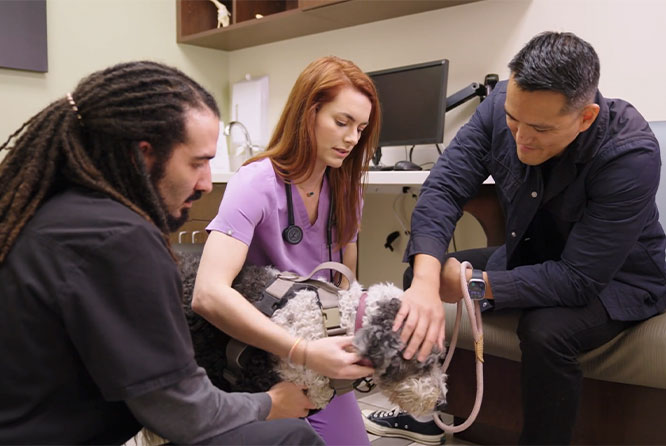It’s Always Flea and Tick Season: Improve Communication to Improve Compliance

How is flea and tick control compliance in your clinic?
If your clients are like those surveyed in this study published in Parasites & Vectors, even if you recommend year-round prevention, only 62% of dog owners will remember this advice. On average, study participants believed their dogs needed around 10.5 months of flea and tick control, and the estimated actual coverage was only 6 months.
This gap in coverage is concerning because fleas and ticks are more than mere pests. These parasites pose significant risks to both pet and human health, and taking a “seasonal” approach is becoming increasingly insupportable due to changing climate conditions.
The study’s troubling numbers highlight the need for veterinary teams to ramp up pet owner education when it comes to fleas and ticks, the risks they carry, and the need for year-round prevention and annual screening for tick-borne disease.
Flea and Tick Control: Communicating the Basics
One of the biggest challenges in flea and tick control is ensuring that pet owners and team members are on the same page. Important topics to cover include:
Tick-borne Disease
Ticks can cause direct disease and act as vectors for various pathogens. The physical presence of ticks can lead to irritation, pruritus at the attachment site, and anemia in severe cases. And according to the Companion Animal Parasite Council (CAPC), all hard tick species should be considered potential pathogen vectors. While Lyme disease is probably the most well-known tick-borne illness in pets, others include ehrlichiosis, anaplasmosis, Rocky Mountain spotted fever, and babesiosis.
Flea-borne Disease
Flea infestations in pets can lead to a range of issues, as well. Heavy infestations, especially in young animals, can result in iron deficiency anemia with potentially fatal outcomes. And flea allergy dermatitis (FAD) is the most common veterinary dermatologic condition. Like ticks, fleas can be vectors for various zoonotic pathogens, including D. caninum (tapeworms), R. typhi (flea-borne typhus), B. henselae (Bartonellosis or cat scratch disease), and even Y. pestis (bubonic plague).
Parasite Life Cycles
You probably don’t need to go into great detail about larvae and nymphs and the exact timing of it all. But considering how many pets are full-time housemates, it may be helpful to inform pet owners that parts of the flea and tick life cycles occur in their homes, as well as on their pets. The thought of flea eggs hatching in carpet can make a compelling case for comprehensive parasite control.
Year-Round Prevention
Flea and tick seasons are a constantly moving target, so CAPC advises against factoring them into your recommendations. Year-round control is the most effective way to prevent infestations, and as the study from Parasites & Vectors indicates, your clients may need to hear this message multiple times and from multiple team members and resources for it to stick. They may also need a reminder system so they don’t skip doses or delay treatments on accident, unintentionally putting their pets at risk.
Indoor Pets
Many pet owners don’t see an immediate need for flea and tick control for pets who live indoors, particularly cats. Explain how parasites can make their way into homes via other animals (especially other pets) and on clothing and shoes. Indoor pets can also encounter fleas and ticks while visiting the groomer, receiving veterinary care, or staying in a boarding facility. This conversation is a good opportunity to discuss environmental tactics for managing parasites, including regular vacuuming, washing pet bedding with hot water, keeping the lawn trimmed, and using pet-safe yard sprays to deter pests.
Prescription vs. Over-the-Counter Options
While OTC options can seem convenient and cost-effective to pet owners, they typically aren’t a good deal in the long run. Explain that by tailoring your parasite prevention recommendations to their individual pet (taking into consideration their temperament, lifestyle, geographic location, preferred mode of administration, home environment, etc.), you can help make flea and tick control safer and more effective. And in areas where Lyme disease is considered endemic or emerging, CAPC recommends vaccinating dogs against B. burgdorferi.
It’s worth noting that many pet owners are unaware that broad-spectrum prescription options have the advantage of protecting dogs and cats against intestinal parasites and heartworm disease, as well. If you need a refresher on available products, CAPC has you covered.
Annual Screening
CAPC recommends screening all pets for tick-transmitted pathogens every year, particularly in areas where pathogens are endemic or emerging. If your patient is on year-round prescription tick control, the pet owner may not see a need for annual screening. Use this opportunity to explain that while preventives are highly effective, bites and disease transmission can still occur. Annual screening is a way to confirm whether the prevention program the pet owner has in place is working.
Unfortunately, it’s always flea and tick season. But the good news is that you can play a significant role in getting your patients the protection they need simply through talking. That’s because clear, consistent communication has been shown to increase client compliance. Encourage your team to seize every opportunity to help pet owners make better informed decisions about their pets’ care.
CTA:
Stay vigilant against vector-borne diseases with Accuplex™
Accuplex™ with C6* offers accurate, affordable canine vector-borne disease screening for:
- Heartworm
- Lyme
- Ehrlichia
- Anaplasma
Experience confident, convenient vector-borne disease screening.
*Detects patient antibodies against the C6 peptide derived from the VlsE protein of Borrelia burgdorferi, the causative agent of Lyme disease. Like all C6 tests, a positive result indicates infection (past or present.) Most infected dogs show no or mild clinical signs, and do not develop the clinical syndrome of Lyme disease.




